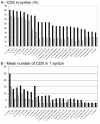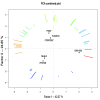Genomes of three tomato pathogens within the Ralstonia solanacearum species complex reveal significant evolutionary divergence
- PMID: 20550686
- PMCID: PMC2900269
- DOI: 10.1186/1471-2164-11-379
Genomes of three tomato pathogens within the Ralstonia solanacearum species complex reveal significant evolutionary divergence
Abstract
Background: The Ralstonia solanacearum species complex includes thousands of strains pathogenic to an unusually wide range of plant species. These globally dispersed and heterogeneous strains cause bacterial wilt diseases, which have major socio-economic impacts. Pathogenicity is an ancestral trait in R. solanacearum and strains with high genetic variation can be subdivided into four phylotypes, correlating to isolates from Asia (phylotype I), the Americas (phylotype IIA and IIB), Africa (phylotype III) and Indonesia (phylotype IV). Comparison of genome sequences strains representative of this phylogenetic diversity can help determine which traits allow this bacterium to be such a pathogen of so many different plant species and how the bacteria survive in many different habitats.
Results: The genomes of three tomato bacterial wilt pathogens, CFBP2957 (phy. IIA), CMR15 (phy. III) and PSI07 (phy. IV) were sequenced and manually annotated. These genomes were compared with those of three previously sequenced R. solanacearum strains: GMI1000 (tomato, phy. I), IPO1609 (potato, phy. IIB), and Molk2 (banana, phy. IIB). The major genomic features (size, G+C content, number of genes) were conserved across all of the six sequenced strains. Despite relatively high genetic distances (calculated from average nucleotide identity) and many genomic rearrangements, more than 60% of the genes of the megaplasmid and 70% of those on the chromosome are syntenic. The three new genomic sequences revealed the presence of several previously unknown traits, probably acquired by horizontal transfers, within the genomes of R. solanacearum, including a type IV secretion system, a rhi-type anti-mitotic toxin and two small plasmids. Genes involved in virulence appear to be evolving at a faster rate than the genome as a whole.
Conclusions: Comparative analysis of genome sequences and gene content confirmed the differentiation of R. solanacearum species complex strains into four phylotypes. Genetic distances between strains, in conjunction with CGH analysis of a larger set of strains, revealed differences great enough to consider reclassification of the R. solanacearum species complex into three species. The data are still too fragmentary to link genomic classification and phenotypes, but these new genome sequences identify a pan-genome more representative of the diversity in the R. solanancearum species complex.
Figures








Similar articles
-
Ralstonia solanacearum virulence increased following large interstrain gene transfers by natural transformation.Mol Plant Microbe Interact. 2011 Apr;24(4):497-505. doi: 10.1094/MPMI-09-10-0197. Mol Plant Microbe Interact. 2011. PMID: 21190441
-
Ralstonia syzygii, the Blood Disease Bacterium and some Asian R. solanacearum strains form a single genomic species despite divergent lifestyles.PLoS One. 2011;6(9):e24356. doi: 10.1371/journal.pone.0024356. Epub 2011 Sep 8. PLoS One. 2011. PMID: 21931687 Free PMC article.
-
Phylogeny and population structure of brown rot- and Moko disease-causing strains of Ralstonia solanacearum phylotype II.Appl Environ Microbiol. 2012 Apr;78(7):2367-75. doi: 10.1128/AEM.06123-11. Epub 2012 Jan 27. Appl Environ Microbiol. 2012. PMID: 22286995 Free PMC article.
-
Ralstonia solanacearum, a widespread bacterial plant pathogen in the post-genomic era.Mol Plant Pathol. 2013 Sep;14(7):651-62. doi: 10.1111/mpp.12038. Epub 2013 May 30. Mol Plant Pathol. 2013. PMID: 23718203 Free PMC article. Review.
-
Pathogenomics of the Ralstonia solanacearum species complex.Annu Rev Phytopathol. 2012;50:67-89. doi: 10.1146/annurev-phyto-081211-173000. Epub 2012 May 1. Annu Rev Phytopathol. 2012. PMID: 22559068 Review.
Cited by
-
Sequencing of K60, type strain of the major plant pathogen Ralstonia solanacearum.J Bacteriol. 2012 May;194(10):2742-3. doi: 10.1128/JB.00249-12. J Bacteriol. 2012. PMID: 22535929 Free PMC article.
-
Complete Genome Sequence of Sequevar 14M Ralstonia solanacearum Strain HA4-1 Reveals Novel Type III Effectors Acquired Through Horizontal Gene Transfer.Front Microbiol. 2019 Aug 14;10:1893. doi: 10.3389/fmicb.2019.01893. eCollection 2019. Front Microbiol. 2019. PMID: 31474968 Free PMC article.
-
From prediction to function: Current practices and challenges towards the functional characterization of type III effectors.Front Microbiol. 2023 Feb 8;14:1113442. doi: 10.3389/fmicb.2023.1113442. eCollection 2023. Front Microbiol. 2023. PMID: 36846751 Free PMC article. Review.
-
Design and dynamic simulation of minimal metallo-proteins.J Mol Model. 2011 Nov;17(11):2919-25. doi: 10.1007/s00894-011-0993-8. Epub 2011 Feb 12. J Mol Model. 2011. PMID: 21318231
-
Draft Genome Sequences of Nine Strains of Ralstonia solanacearum Differing in Virulence to Eggplant (Solanum melongena).Genome Announc. 2016 Jan 28;4(1):e01415-15. doi: 10.1128/genomeA.01415-15. Genome Announc. 2016. PMID: 26823572 Free PMC article.
References
-
- Yabuuchi E, Kosako Y, Yano I, Hotta H, Nishiuchi Y. Transfer of two Burkholderia and an Alcaligenes species to Ralstonia gen. Nov.: Proposal of Ralstonia pickettii (Ralston, Palleroni and Doudoroff 1973) comb. Nov., Ralstonia solanacearum (Smith 1896) comb. Nov. and Ralstonia eutropha (Davis 1969) comb. Nov. Microbiol Immunol. 1995;39:897–904. - PubMed
-
- Hayward AC. Characterristics of Pseudomonas solanacearum. J Appl Bacteriol. 1964;27:265–277.
-
- Buddenhagen I, Kelman A. Biological and physiological aspects of bacterial wilt caused by Pseudomonas solanacearum. Annual Review of Phytopathology. 1964;2:203–230. doi: 10.1146/annurev.py.02.090164.001223. - DOI
-
- Elphinstone JG. In: Bacterial Wilt: The Disease and the Ralstonia solanacearum species complex. Allen C, Prior P, Hayward AC, editor. St. Paul, Mn, USA: APS Press; 2005. The current bacterial wilt situation: A global overview.
-
- Janse JD, van den Beld HE, Elphinstone J, Simpkins S, Tjou-Tam-Sin NAA, van Vaerenbergh J. Introduction to Europe of Ralstonia solanacearum biovar 2, race 3 in Pelargonium zonale cuttings. J Plant Pathol. 2004;86:147–155.
Publication types
MeSH terms
Substances
LinkOut - more resources
Full Text Sources
Other Literature Sources
Molecular Biology Databases

